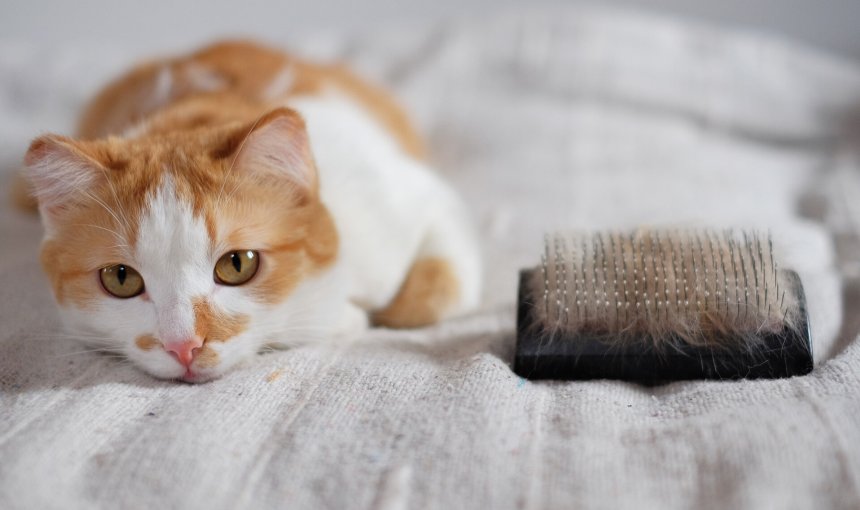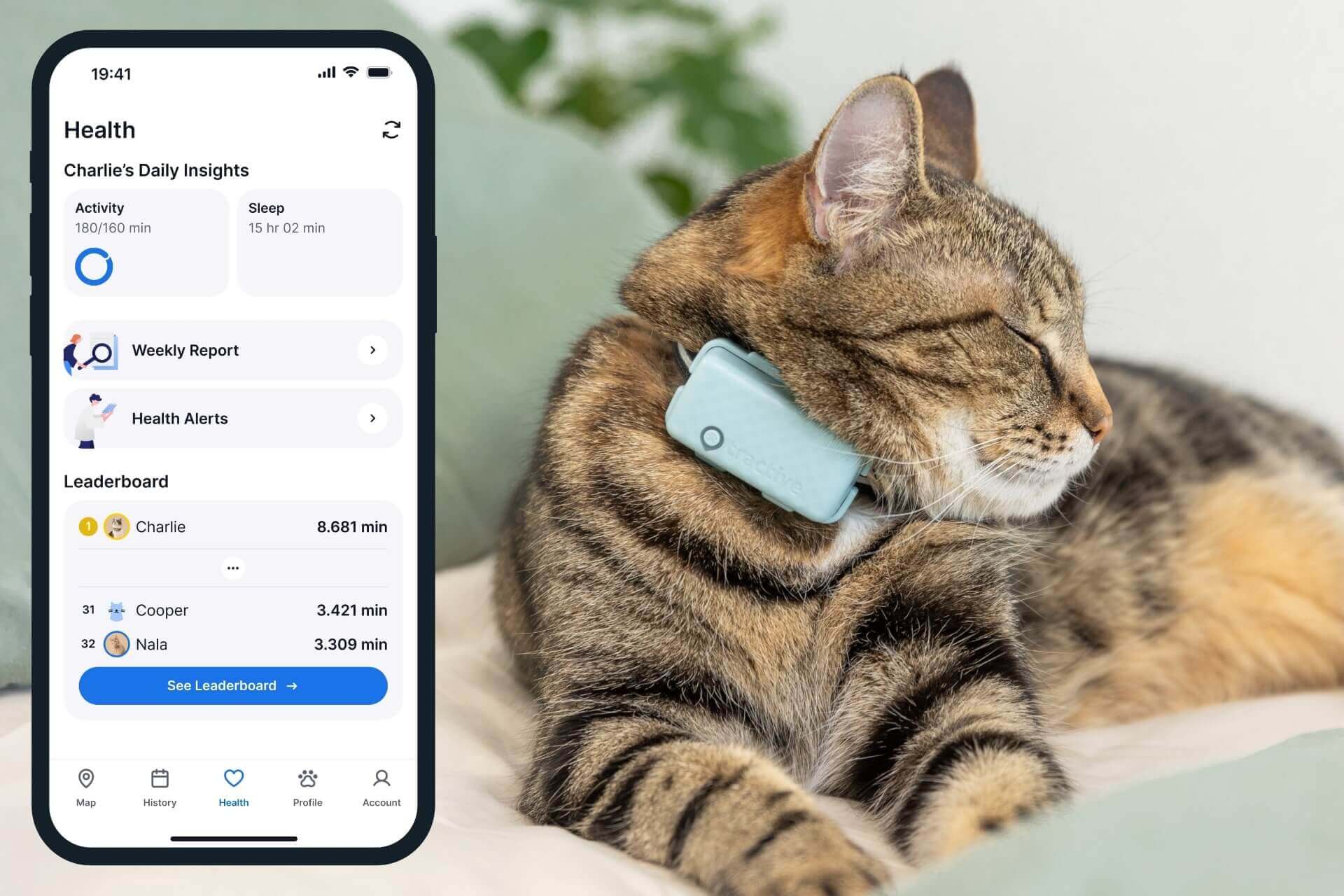 Approved by Dr. Dwight Alleyne, DVM
Approved by Dr. Dwight Alleyne, DVM Cat Losing Hair? Here Might Be The Reasons Why
It can be pretty alarming to find your cat licking themselves bald - or showing patches of missing fur! So if you're wondering - why is my cat losing hair? - you're in the right place. Let's dive into all the reasons why & what you can do to prevent it.

If you’ve found yourself vaccuming cat hair off your couches, carpets, curtains, clothes more often than usual – you might find yourself wondering: is my cat losing hair? Am I seriously dealing with a case of cat alopecia here – or is it normal? Let’s break down the reasons you’ve got a cat losing hair all over your home – and how you can catch on to an illness early by keeping an eye on how well they’re sleeping, plus the impact this has on their energy levels.
Key Takeaways
If you notice your cat is losing hair in patches, has bald spots, sores, or scabs, it could be a sign of a health issue called “alopecia.”
The most common reasons for a cat losing hair include anxiety and stress (which causes them to lick or overgroom themselves), pain, an infection from bugs like fleas and mites, or an allergic reaction to food or something in the environment.
If you see your cat losing hair, scratching a lot, or acting less energetic, you should take them to the vet. They might need a special diet, medicine, or medicated shampoo to treat the underlying cause.
Since cats are very good at hiding when they are in pain or sick, you can use the Tractive tracker’s Activity and Sleep Monitor. It will send you a Health Alert if it notices a sudden drop in their activity or a change in their sleep, which can be the first sign that something is wrong.

Find out where your cat spends their time.
Read moreWhy is my cat losing hair? The less concerning reasons
Hair loss in cats is medically referred to as “alopecia” – and in many cases, it’s due to multiple causes. Here are some of the (slightly) less concerning ones:
- Age
With kittens, it’s more common when they’ve just been born.1 - Breed
Some cat breeds are inherently “hairless” – like Sphynx cats. Other cat breeds are born with thin coats which they eventually lose over time (like Siamese cats). Still others (like Cornish Rex cats) are born with full coats, which eventually sheds over time. - Habits
Outdoor cats might get into fights with other cats (and animals) over territorial disputes. Which might lead to a few “battle scars” – including their fur. - Pregnancy
In pregnant cats, hormonal changes might trigger some hair loss. Which usually isn’t permanent and may regrow.
When a cat losing hair may be cause for concern
One of the first concerning signs if you’ve got a cat losing hair is if you notice some patches of their fur thinner than the rest of their coat. Plus, if you’re observing your cat losing hair on top of other symptoms of sickness – that’s when it makes sense to drop by your local vet. These might include:
- Sores, scabs, or red, irritated skin
- Bald patches
- A loss of appetite
- A bloated, distended belly
- A drop in your cat’s energy levels
These can signal that your poor cat’s struggling with an allergy, infection, or some other serious health condition.

Get health alerts for your cat
Our cats can’t always tell us if something’s wrong. But if their tracker detects unusual changes in their routine, you’ll get an alert, helping you catch potential issues early.
More concerning reasons you’ve got a cat losing hair
A change in routine
Boredom, stress, and anxiety can all cause your cat to overgroom themselves.2 Which, with time, might lead them to develop scabs and lose hair in patches around their body. This could be a change in routine like you shifting apartments, bringing home a new pet (or baby) or your neighbors beginning a construction project. Or if your outdoor cat now has to stay indoors, they might feel bored and frustrated from the lack of enrichment.
Anxiety
Psychogenic alopecia is a behavioral issue where your cat might overgroom themselves due to anxiety.3 In fact, grooming helps calm your cat down – it’s comforting in the same way Mama Cat might’ve done it when yours was still a kitten. It can help relieve their anxiety when they feel “threatened” (either by your new puppy or the vaccum next doors.)
⚠️ On top of this, if your cat is dealing with an infection, allergic reaction, or pain – it can cause them stress as well. (Leading to more overgrooming – and more hair loss.)
Pain
If you’re now wondering – my cat has patches of fur missing and sores…what gives? – it might be due to pain. In fact, overgrooming a specific part of their body might lead to hair loss as your cat tries to relieve pain in that area.4 So a cat with joint pain might overgroom a particular limb – or even end up with a bald spot on their sides or belly from a stomach ache.
Infection
Alopecia in cats might also be caused by infections – especially from these common sources:
- Bacteria, including Staphylococcus
- Yeast, including Malassezia
- Ringworm
- Parasites (including ticks, fleas, lice, and mites)
Even if yours is primarily an indoor cat, they’re still vulnerable to these pesky critters in your home. All of these infections tend to make your cat itchy – so they might bite, scratch, and overgroom themselves until you’ve got a serious case of cat hair loss at hand.5
Besides, your cat might be likely to pick up an infection from other animals they encounter (both indoors and outdoors), contaminated surfaces, including food and water bowls, toys, bedding, and even you – since viruses and bacteria can often cling to our clothing and transfer on to our pets (though not the other way round)
So if your cat likes to wander the outdoors, it’s possible they’re venturing into areas riddled with parasites. (Like fleas and ticks – that tend to be most active around spring, summer, and fall.)
Read more: How To Prevent & Get Rid Of Ticks On Cats (For Good)
Allergies
Besides infections, another reason you’ve got a cat losing hair all around your house might be allergies.6 These include:
- Environmental allergens, like pollen, dust, or common household items like cleaning fluids and the like.
- Other parasitic critters, like fleas. In fact, Flea Allergy Dermatitis (FAD) is a common cause for itching and overgrooming in cats. Your poor cat might even end up vomiting up a hairball from swallowing so much of their fur!
- Food allergies to specific ingredients, which tend to be less common in cats – but which can cause them to scratch and groom themselves excessively.
Other medical conditions
Finally, a whole range of health conditions may cause your cat discomfort – leading them to overgroom themselves and lose their hair as a result.8 Including:
- Urinary tract infections (UTIs), which involve an inflammation of their bladder, kidneys and/or other urinary organs. Watch out for signs like your cat peeing around the house – or too little in general.
- A gastrointestinal disease, which might cause stomach pains and upset. Your cat might lick their belly areas excessively as a result, leading to patches of hair falling out.
- An infection of their anal organs, which might lead your cat to “scoot” or drag themselves around the floor on their butts.
- Hyperthyroidism, which might also cause your cat to be restless and more hyperactive than usual.
- Cushing’s disease, which is less common in cats, but includes symptoms like hair loss, itching, and skin infections.
- Cancers, including lymphoma and pancreatic carcinoma.
- Diabetes, where skin infections and slow-healing wounds might be common.
- Pancreatic, liver, and adrenal disorders, all of which are linked to more fragile, easily irritated skin in cats.
How your vet might diagnose & test for cat alopecia
Your vet will start by thoroughly examining your cat for fleas, ticks, and mites. If your cat mostly has hair loss around the base of their tails and lower back, it could be fleas. Below the tail hair loss could signal an infection of their anal organs.9 Once that’s done, your vet might perform these diagnostic tests:
- A skin biopsy, or surgically removing a small patch of your cat’s skin to view under a microscope.
- Skin scraping to look for other parasites.
- A blood and/or urine test to rule out health issues like hyperthyroidism or diabetes.
- Allergy testing, including with an elimination diet trial. Your vet might prescribe you a special, hypoallergenic diet for your cat instead.
- Ultrasound imaging to rule out any signs of cancer.
Only once your vet has ruled out all other causes, they might also consider psychogenic alopecia as another possible reason.
Treating alopecia in cats
Medical treatments for cat hair loss
Using a special cone collar can help prevent your cat from biting or scratching at any infected skin. This can help your cat’s skin heal and their hair regrow. Else, your vet might prescribe specific medications, including antihistamines, can help reduce itching.10 Antibiotics can help target specific fungal infections that cause itching and discomfort and medicated shampoos can help tackle parasitic infections. Steroid creams can also help reduce itching when you apply it to the spots your cat’s been grooming. (Just make sure to prevent your cat from licking off the cream! Here’s where a cone collar can come in handy.)
Your vet might also recommend an 8-12 week elimination diet, where you remove specific ingredients from your cat’s meals and observe their reactions.
Home treatments for cat hair loss
Do a thorough cleanup of your home to get rid of fleas, ticks, and mites. Clean your bedding and other surfaces your cat tends to sleep on. Double check that their food and water bowls are clean and aren’t being shared by other animals. Likewise, make sure your backyard isn’t too overgrown. (As pests like ticks tend to thrive in thick vegetation.)
You could also help your cat reduce their stress with tons of attention, cuddles, playtime, and keeping them occupied while you aren’t around. Scratching posts and food puzzles can keep your cat from getting bored or lonely when you’re not at home.11 Brushing your cat’s coat regularly can also prevent matting or tangling – plus you can pick up early on critters like ticks or fleas.
Finally, monitor what your cat’s been eating. Many harmless (and even healthy) human foods can make cats very sick and trigger an allergic reaction. Cat food brands that are rich in omega-3 fatty acids can help improve their skin and promote healthy hair growth.
Where a smart cat collar can help
Since hair loss in cats can stem from so many different issues – stress, over-grooming, skin infection, or pests – a Tractive smart cat collar can help you figure out what’s causing the problem and how to better manage it. With one, you can now:
Understand what’s causing itching in your cat’s environment
If your cat is losing hair due to constant itching (from pests or allergies) or licking a specific area, the tracker can help you figure out the trigger. By reviewing their Location History, you can see if the problem coincides with them spending a lot of time in a new spot. The Heatmap highlights where your cat rests or spends the most time. Is it a dusty corner of the basement, a spot where they encounter other neighborhood cats, or a place they shouldn’t be? Identifying these hotspots can point you toward the external cause.

Else, if your cat is an indoor/outdoor adventurer, the real-time GPS tracking lets you see exactly where they go. If they visit areas known for high pests (like woodpiles) or aggressive neighborhood cats (a source of stress), you can link that behavior to the hair loss.
Spot potential health issues early
Over-grooming and constant scratching – common reasons for hair loss – will severely interrupt your cat’s rest. Besides location, your tracker also monitors their sleep quality. You might not see the restless nights, but the data will show if their sleep is broken and poor. Similarly, if they are stressed (another major cause of fur loss), they might show unusual restlessness or a drop in activity.
If the hair loss and underlying issue are causing severe discomfort or stress, leading to a big change in their normal activity or sleep, the Health Alerts will notify you instantly. This objective data on sleep quality and activity changes is valuable info for your vet, helping them treat the root cause of the alopecia faster.

Your furry friend’s health and wellbeing means as much as to us as it does to you. So we’ve made it a priority to only share medically-relevant content on our blog. This post was checked, double-checked, and medically verified by Georgia-based vet, Dr. Dwight Alleyne.

Dr. Dwight Alleyne, DVM
Originally from Long Island, New York, Dr. Alleyne began his career at a no-kill animal shelter before becoming a licensed veterinary technician. He graduated from Cornell University Veterinary College in 2006 and completed an internship at Purdue University. Now practicing in Georgia, Dr. Alleyne specializes in soft tissue surgery and ultrasounds. He also writes pet health articles on his website, “The Animal Doctor Blog” (www.anmldrblog.com).



